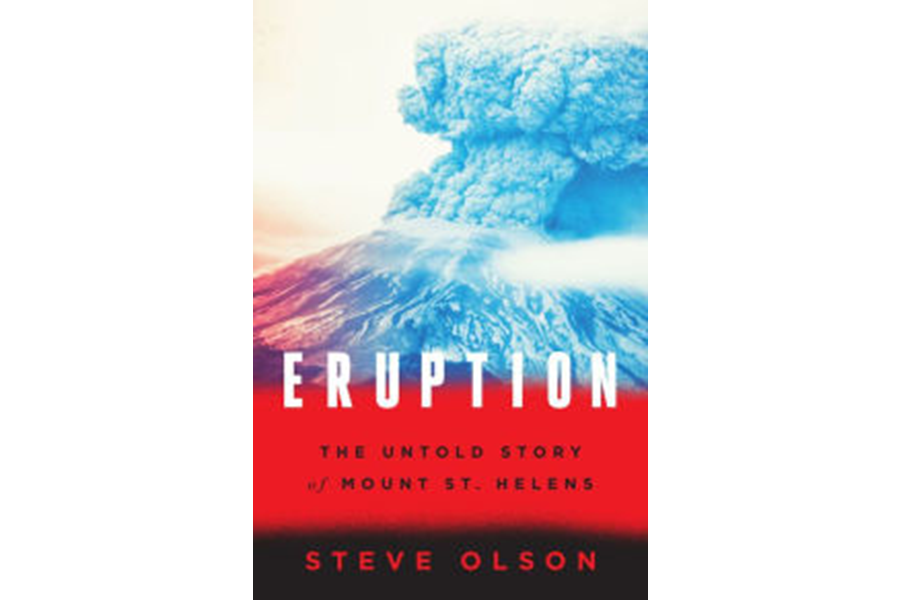'Eruption,' in an evocative retelling, places Mount St. Helens in context
Loading...
The day that Mount St. Helens blew its side – not its top – is imprinted on the minds of millions of people in the Northwest who were alive and aware in 1980. They remember exactly where they were when they heard the news.
Not that anyone heard the eruption itself in the first few moments. Sightseers flying overhead detected no sounds but their small plane’s engine’s buzz and their own startled shouts. Their eyes were busy enough: They watched a towering column of dark ash billow into an anvil shape over the mountain, “shot through with lightning – pink and purple and yellow.”
Next came the biggest volcanic avalanche in history. Floods and countless tons of ash covered the land for miles. Forests of trees blew over, homes and cars were obliterated, and 57 people lost their lives.
Despite the blame cast their way, many of the victims weren’t careless themselves. They just didn’t understand the risk they faced and fell victim to a lethal combination of hubris, lack of imagination, and ignorance displayed by those who could (and maybe should) have known better. Specifically, those who monitored the mountain and those who made the rules.
The story of Mount St. Helens is a shocking tale of destruction and grief. But in his evocative and convincing new book, author Steve Olson reveals that the eruption – the most powerful natural disaster to ever strike the US – is much more than a horror show.
Eruption: The Untold Story of Mount St. Helens uncovers the catastrophe’s critical place in the histories of science, logging, the environmental movement, and the Pacific Northwest itself. It came at a time of epic transition.
By 1980, the mammoth logging industry of the Pacific Northeast was in trouble. Eight decades after logging clans like the Weyerhaeuser family flocked to Washington and Oregon, the industry faced big challenges from the fledgling environmental movement. And then, near southwestern Washington’s border with Oregon, a volcano inconveniently began to act up.
Mount St. Helens blew off steam and ash, shook the region with earthquakes and grew a nasty bulge on its side. While leery loggers kept working with wary eyes peeled, geologists, journalists, and lookie-loos flocked to watch.
As Olson puts it, the volcano’s harmless belching “was a wonderful diversion in an unhappy time in the nation’s history.” At the time, the economy stunk, a president was on his way out, and Iran held Americans hostage. In the Northwest, massive Boeing layoffs, a breakdown of logging, and an exodus of residents made the region seem to “be teetering on the edge of insolvency.” A snarky billboard near the Sea-Tac airport put it best: Will the Last Person Leaving SEATTLE – Turn Out the Lights.”
Why not enjoy the spectacle? What’s the worst that could happen? Much worse than what actually happened, in fact: The weekend timing of the eruption saved many lives. But the eruption was still an epic disaster.
Informed by hundreds of interviews and intensive research into documents, Olson vividly chronicles the eruption through the stories of the victims and the witnesses (including 138 people, 8 dogs, and 1 boa constrictor, all taken by helicopter to safety).
The scientists knew the potential for trouble, but they underestimated the power of a sideways eruption through that bulge. Corporate logging types tried too hard to protect their industry, government officials didn’t take the threat seriously enough, and the media turned a doomed elderly hanger-on named Harry Truman into a celebrity instead of a cautionary tale.
Olson tracks the human errors and failures, but he didn’t write this book to point fingers after the fact. He has a bigger picture in mind, one of the eruption’s role as a touchstone for an evolving society and natural world.
Today, Americans have cut down an estimated two-thirds of all the volume of wood in all US forests in the Lower 48 states. But even in an era when President Reagan’s secretary of the interior had once wondered darkly if “extreme environmentalists” sought to “weaken America” (sound familiar?), environmentalists managed to save much of the land around the volcano from logging. Decades later, the green movement remains strong.
Meanwhile, scientists and forestry officials are much better at monitoring and managing the risk of volcanoes after their massive failure to give attention to “the worst things that could happen.” And the Northwest has spun away from nature-destroying heritage, becoming a paradise for both lovers of the outdoors and indoor enthusiasts who prefer screens to streams. As Olson notes, the region is both high-tech and no-tech, a blend he calls just fine.
Mount Saint Helens, a pleasant day trip from Portland, remains a “ripped-open mountain” laid low by forces beneath. But it’s simply biding its time, waiting to erupt again and – like every natural disaster – test the powers of humanity to plan and predict and react.
We can only hope we remember the lessons of experience won at such a painful price.








